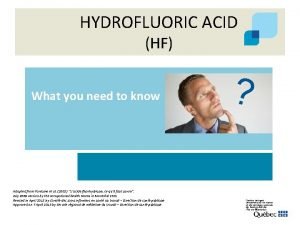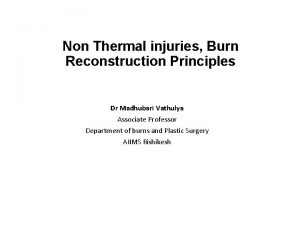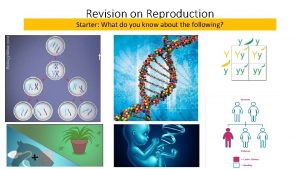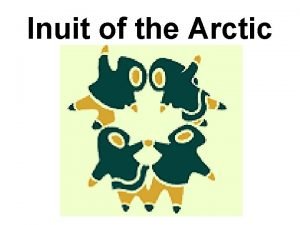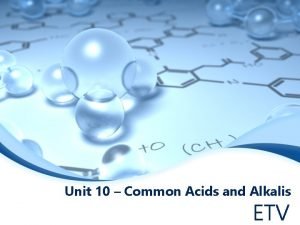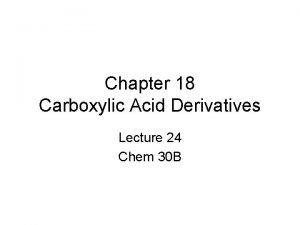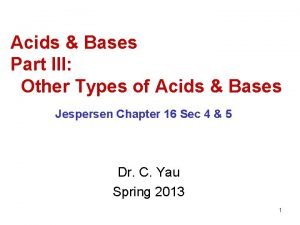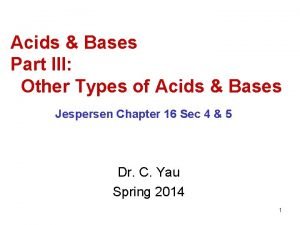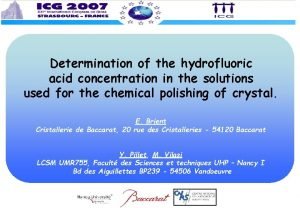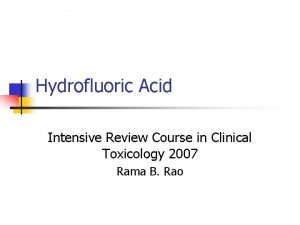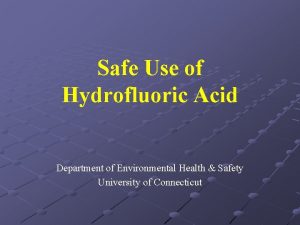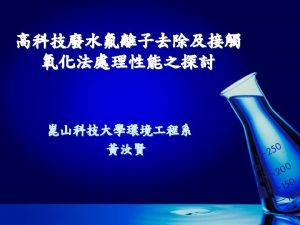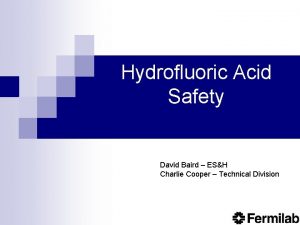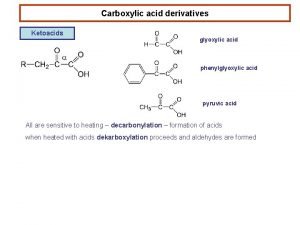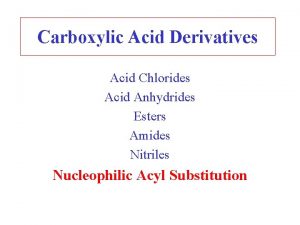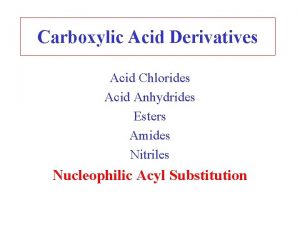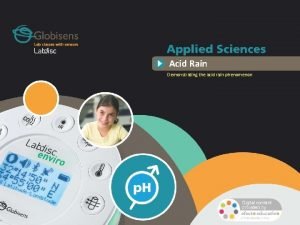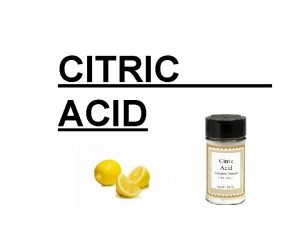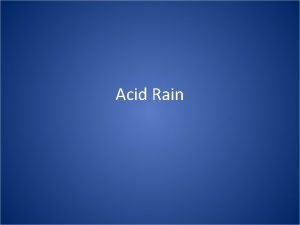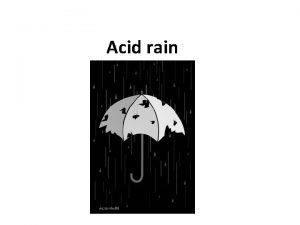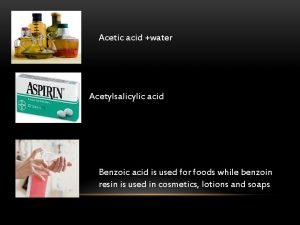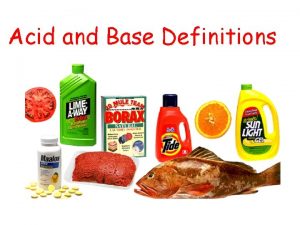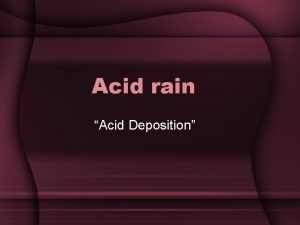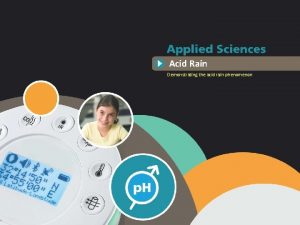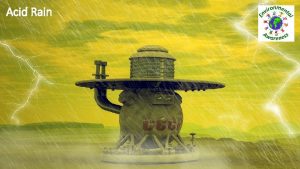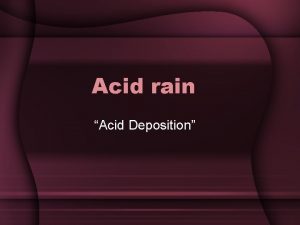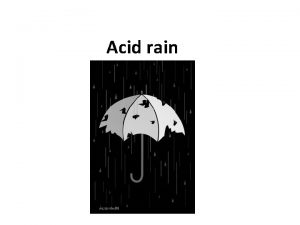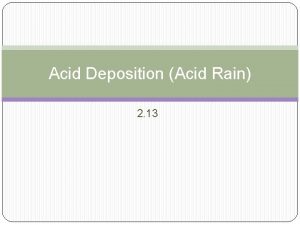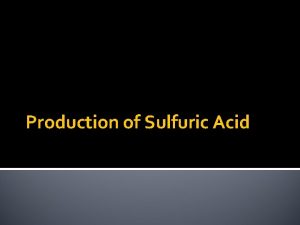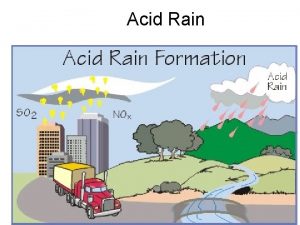HYDROFLUORIC ACID HF What you need to know




























- Slides: 28

HYDROFLUORIC ACID (HF) What you need to know Adapted from Fontaine et al. (2005) "L’acide fluorhydrique, ce qu’il faut savoir". July 2008 version by the occupational health teams in Montréal CSSS. Revised in April 2015 by Comité des soins infirmiers en santé au travail – Direction de santé publique Approved on 7 April 2015 by Service régional de médecine du travail – Direction de santé publique ?

Objectives § What is HF? § Where is it found? § What are the health effects? § Recognizing at-risk situations § Providing first aid in case of accidental exposure § Adopting safe work methods 2

HF is a chemical solution. . . § Made of hydrogen fluoride mixed with water (concentrations vary from 0. 1% to 100%) § That produces toxic, irritating and corrosive vapours § That evaporates easily § That is colourless 3

According to WHMIS Class E § Corrosive effects E. g. : Burns Class D 1 B, D 2 A § Toxic effects E. g. : Heart problems 4

Where is HF found? 5

Routes of entry Nose Skin Eyes Mouth 6

Health effects Lungs Skin Eyes Digestive system 7

Health effects: Inhalation Palpitations Disordered heart rhythms Burns in the lungs Water on the lungs Convulsions Tingling 8

Health effects: Ingestion Burns (mouth, throat) State of shock Ulcers 9

Health effects: Contact with skin Concentration Pain Consequences 50% + Immediate and intense Wounds or necrosis 20% to 50% 1 to 8 hours after the accident Redness, pale skin, blisters 0, 1% to 20% 24 hours after the accident Redness 10

Health effects: Contact with eyes § Tears § Red eyes § Swollen eyes § Pain § Whites of the eyes damaged § Loss of eyesight 11

At-risk situations ? 12

At-risk situations § Lack of awareness § Unsafe work methods § Personal protective equipment unavailable, inadequate or not used § Poor hygiene measures § Industrial equipment break § Increase in tank temperature 13

At-risk situations: Examples Using bare hands to wring out a cloth contaminated with a chemical product Cleaning personal protective equipment or work tools with bare hands Eating or drinking at a workstation Slipping on a surface on which a chemical product has spilled 14

Prevention methods § Substituting another product for HF § Closed process (no contact) § Evacuation plan § Information § Personal protective equipment § Work methods § First aid 15

First aid in case of accidental spill § Act quickly § Apply the emergency measures plan or evacuation protocol § Call 9 -1 -1 § Tell the operator that there's been an HF leak and your location § Use adequate personal protective equipment § Read the material safety data sheet to know what to do in case of a spill or leak 16

First aid: Inhalation § Wear personal protective equipment: • Mask and oxygen tank (e. g. respiratory equipment used C Air Pack) by firefighters, Scott AU TI • Coveralls ON • Neoprene gloves ! § Take the victim out of the dangerous zone, if personal protective equipment is available 17

First aid: Inhalation IF YOU DON'T HAVE personal protective equipment Victim CAN'T move § § Don’t go into the danger zone Wait for the firefighters Victim CAN move § § § Ask the person to leave the area Put on neoprene gloves, if available Rince the victim's skin under running water 18

First aid: Inhalation If the victim IS BREATHING Oxygen recommended and available § § Place the person in a comfortable position Administer 100% oxygen using a high concentration mask with a reservoir bag 19

First aid: Inhalation Oxygen recommended and available If the victim ISN'T BREATHING § § Perform resuscitation Give 100% oxygen using a bag-mask device DON'T perform mouth-to-mouth DON'T use a mask with a one-way valve 20

First aid: Ingestion § § Victim is CONSCIOUS Victim is UNCONSCIOUS Ask the person to rinse his or her mouth with water § Place the victim on his or her side § Monitor ABC Ask the person to either § drink a glass of milk take 4 tablespoons of Maalox § have a TUMS DON'T induce vomiting 21

First aid: Skin contact Antidote UNAVAILABLE § Put on neoprene gloves § Remove the victim's clothing under the emergency shower § Rinse the skin under running water until ambulance attendants arrive § Examine the victim to see if all affected body parts have been rinsed § Dispose of the victim's clothing correctly 22

First aid: Skin contact Antidote AVAILABLE 23

First aid: Skin contact Antidote AVAILABLE § Put on neoprene gloves § Remove the victim's clothing under the emergency shower § Rinse the skin under running water for 3– 5 minutes § After rinsing, apply the antidote every 15 minutes and massage continuously until pain is relieved or ambulance attendants arrive § Examine the victim to make sure the antidote has been applied on all affected body parts § Use a new pair of neoprene gloves to avoid HF contamination 24

First aid: Eye contact § Put on neoprene gloves § Remove the victim's contact lenses carefully, if required N N TH NT station for about 15 minutes E IDO EY T § Cover the eyes with sterile non-adhesive ES E O § Rinse the victim's eyes under IN A running water at the eye-wash pads and affix the 25

First aid: Reminder § Call 9 -1 -1 § Contact Québec's Poison Control Centre at 1 -800 -463 -5060 § Symptoms can appear immediately or a few days after exposure § Always see a doctor when there is accidental exposure 26

First aid: Reminder Don't forget to give ambulance attendants § The product safety data sheet § The antidote on hand § An oral report of the situation and what has been done 27

Conclusion § HF is a powerful acid that can cause serious damage to workers when there is an accident § Replace HF with another product if possible § Do you use HF? Preventive measures must be put in place: q Adopt strict and safe work methods q Organize appropriate and effective first aid 28
 Hydrofluoric acid
Hydrofluoric acid Thomas martin lowry
Thomas martin lowry Hydrofluoric acid
Hydrofluoric acid Hydrofloric acid
Hydrofloric acid Everything you need to know about the odyssey
Everything you need to know about the odyssey Five things we need to know about technological change
Five things we need to know about technological change The dentist told me
The dentist told me Lesson plan kvs bangalore region
Lesson plan kvs bangalore region Need to know basis
Need to know basis The lady and the spider by robert fulghum
The lady and the spider by robert fulghum Know history know self
Know history know self Normalizing flow
Normalizing flow I know who goes before me
I know who goes before me Wish strength
Wish strength Split direct speech worksheet
Split direct speech worksheet You know minecraft
You know minecraft Happy and know it snapchat
Happy and know it snapchat You're a poet and you don't know it
You're a poet and you don't know it When you're blue and you don't know
When you're blue and you don't know How do you know if you're asexual
How do you know if you're asexual Do you know who you are
Do you know who you are I will follow you follow you wherever
I will follow you follow you wherever My wish for you is that life becomes
My wish for you is that life becomes 9-which acid is not considered a strong acid?
9-which acid is not considered a strong acid? Differentiate between acid fast and non acid fast bacteria
Differentiate between acid fast and non acid fast bacteria Reduction of ester
Reduction of ester Acid fast and non acid fast bacteria
Acid fast and non acid fast bacteria Identifying lewis acids and bases practice
Identifying lewis acids and bases practice Lewis acid bronsted acid
Lewis acid bronsted acid
